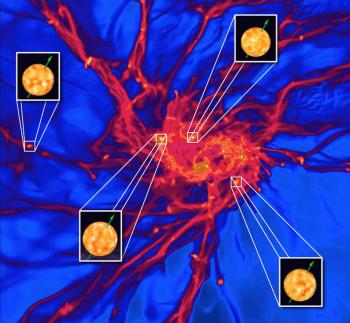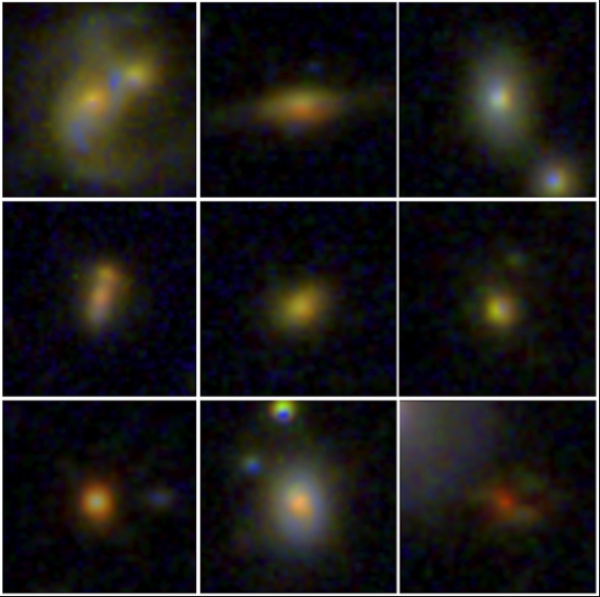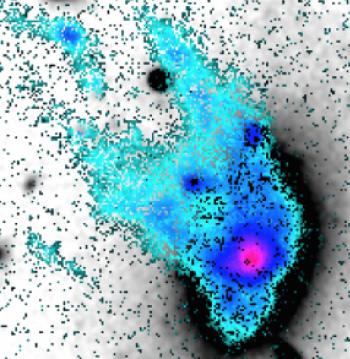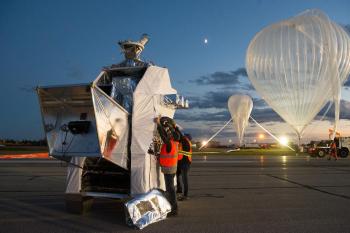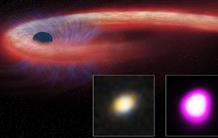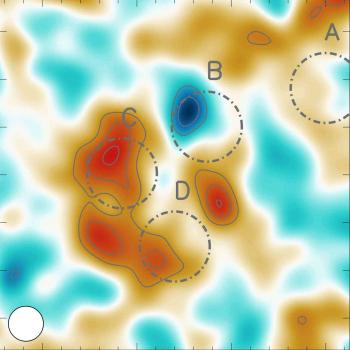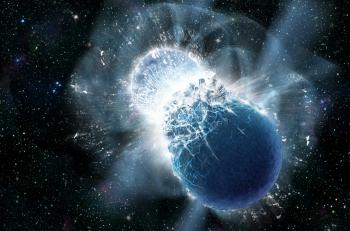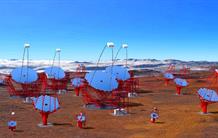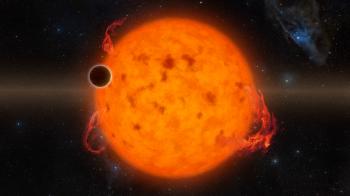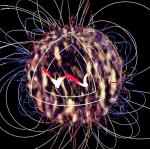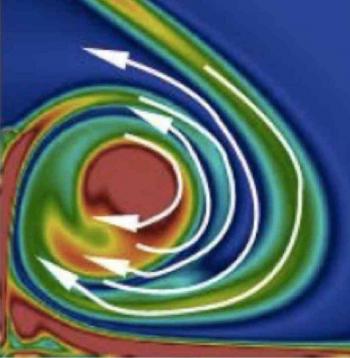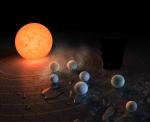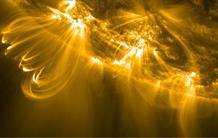Highlights 2017
The proto-clusters, which are the birth sites of stars, are formed non-uniformly inside molecular clouds of the interstellar medium. Studying the steps leading to the collapse of pre-stellar dense cores is essential to understanding the star formation. Using both numerical simulations carried out on massively parallel computers and an analytical approach, two researchers from the Astrophysics Department / AIM Laboratory of CEA-Irfu, Y.-N. Lee and P. Hennebelle, have shown that certain properties of a stellar cluster are determined before the star formation starts, especially in the gaseous phase and that the gravity and turbulence play a major role. This work, published in two articles in the journal Astronomy & Astrophysics, provides a better understanding of parameters related to star formation such as the initial mass function and their efficiency and rate.
The stars do not play dice! It is the extraordinary discovery that the researchers of the Department of Astrophysics-Laboratoire AIM of the CEA-Irfu made by succeeding in determining the orientation in the space of the axis of rotation of stars belonging to two clusters of stars, thanks to asteroseismology. About 70% of the observed stars have perfectly aligned axes of rotation, in formal contradiction with the star formation models which predict that these axes of rotation should be randomly distributed. Numerical simulations showed that, most likely, these stars had managed to retain the initial rotational motion of a cloud that gave rise to the cluster. This discovery, if confirmed in other clusters, could lead to reconsideration of the fundamental processes of star formation. These works make headlines in the journal Nature Astronomy of March 13, 2017
Watch the author's interview : The mysterious alignment of the rotation axis of stars
The mysterious alignment of the rotation axis of stars 
Using images obtained with the Hubble Space Telescope, an international team of researchers led by Yu-Yen Chang from the Service d’Astrophysique-Laboratoire AIM at CEA–IRFU showed that some galaxies hosting an active nucleus are much more compact than those without nuclear activity. This discovery sheds new light on the physical processes driving the evolution of super-massive black holes at the center of distant galaxies. It suggests that the huge amount of gas needed for their growth could be funneled to the central region following the violent gravitational instabilities that occur within the galaxy gaseous disk. These instabilities may trigger a phase a dynamical contraction, hence explaining the ultra-compact morphology of the galaxies studied here. These results are published in the Monthly Notices of the Royal Astronomical Society.
An international team including a researcher from the AIM Laboratory-Astrophysics Department of CEA-Irfu has just discovered an elliptical galaxy of completely unexpected shape within the galaxy cluster Abell 2670. Deep observations made by the new MUSE multi-spectrograph recently put into operation at the European Observatory VLT in Chile revealed a highly deformed elliptical galaxy, showing in particular long gas tails and star formation regions normally absent in this type of galaxy. Astronomers now assume that this galaxy has undergone a recent fusion with another gas-rich galaxy. Much of this gas was then driven to the center of the elliptical galaxy during the collision. These results are published in the Astrophysical Journal Letters of May 2017
The PILOT astrophysics experiment has been launched the 17th April under a stratospheric balloon from Alice Springs in central Australia. The aim is to observe the polarization of the emission of dust particles present in the interstellar medium of our Galaxy and the nearby galaxies. With a mass of nearly one ton, PILOT [1] uses the biggest balloons launched by the National Center for Space Studies (CNES). It was developed by the Institute for Research in Astrophysics and Planetology (CNRS / CNES / Paul Sabatier University) and the Institute of Space Astrophysics (CNRS / Université Paris-Sud) and the Institute of Research into the Fundamental Laws of the Universe (CEA-Irfu). Detectors capable of detecting infrared radiation from dust have been developed at the CEA and are the result of research done to realize the PACS camera that equiped the Herschel space observatory.
At the center of a small galaxy located about 1.8 billion light-years from Earth, a giant black hole swallowed a star for about a decade, which is exceptionally longer than any observed episode of this kind. This discovery was made by an international collaboration involving an astrophysicist from IRFU, thanks to a trio of orbiting X-ray telescopes.
A team of researchers led by Rémi Adam (Laboratoire Lagrange - OCA, UCA, LPSC Grenoble, CNES), Iacopo Bartalucci and Gabriel Pratt (Astrophysics Department- AIM Laboratory at CEA-Irfu) obtained for the first time an image of the gas velocity in colliding clusters of galaxies with NIKA [1], a new generation millimeter camera, at the focus of the 30 m diameter IRAM telescope of Pico Veleta (Spain). NIKA observations, which give accurate mapping of hot gas velocity in clusters, provide a new way to study the collision of clusters of galaxies, responsible for the most energetic events in the Universe after the Big Bang. This work is being published in the journal Astronomy & Astrophysics..
Using a range of detectors developed with the participation of the CEA, physicists at CEA-Irfu have scrutinized the region from which the gravitational wave was detected on August 17, 2017 by LIGO-VIRGO facilities. Unlike the four previous detections of waves of the same type discovered since 2015, this new vibration of space, called GW170817, is of different origin. It does not result from the fusion of two black holes but of two densest known stars, the neutron stars.
Thanks to the INTEGRAL satellite in orbit, the astrophysicists of the Department of Astrophysics-AIM Laboratory (CEA, CNRS, Univ Paris Diderot) were able to show that the wave GW170817 was accompanied by a gamma burst, a brief emission of gamma rays emitted just 2 seconds after the fusion of the two stars. By pointing in record time one of the giant telescopes of the VLT (Chile), they also participated in the study of the visible light emission that followed the fusion, showing in particular that this light was not polarized.
Physicists from the Department of Particle Physics of CEA-Irfu also analyzed the data obtained by the ANTARES experiments for neutrino and H.E.S.S. for the search for very high energy gamma rays, showing that the GW170817 wave did not provide detectable emission.
The study of this new phenomenon, never observed directly so far, offers many exciting perspectives for astrophysics as the possibility of better understanding the origin of the heavy elements of the Universe and even the ability to measure in a complete independent way the rate of expansion of the Universe.
All of these outstanding results are published in a series of articles presented in the journals Nature, Astrophysical Journal and Physical Review Letters on October 16, 2017.
For more information : see the French version
The Cherenkov Telescope Array (CTA) consortium brings together 1300 scientists from 32 countries. They have published their scientific aims in a document over 200 pages long. This is the result of several years of work, and includes contributions from approximately fifteen Irfu researchers involved in X-ray and gamma-ray observatories (Fermi, Integral, XMM-Newton, H.E.S.S., etc.).
A large part of the exoplanets known today are in very close orbit around their star, allowing very intense interactions between the planets and the host star. An international collaboration, led by researchers from Department of Astrophysics-AIM Laboratory at CEA-Irfu, has shown that these planets in close orbits migrate rapidly, due to the combined effect of tidal forces and magnetic forces. This study provides essential elements for understanding the formation and evolution of star-planet systems. These migration effects should soon be observable by missions like PLATO (PLAnetary Transits and Oscillations of Stars) of the European Space Agency (ESA) which will study the habitability zone of the planets. These results are published in the October 2017 issue of Astrophysical Journal Letters.
Thanks to new numerical simulations, a scientific team led by researchers from the Astrophysics Department-Laboratory AIM of CEA-Irfu has succeeded in explaining why the magnetic field of the Sun reverses every 11 years. Scientists have highlighted the existence of a strong feedback between the star magnetic field and its internal rotation profile, with temporal modulations that ultimately determine the period of the cycle. This major discovery in the understanding of the origin of the star magnetic fields is published on July 14, 2017 in the journal Science.
See the video :  The magnetic cycle of the Sun in virtual reality (CEA Astrophysics)
The magnetic cycle of the Sun in virtual reality (CEA Astrophysics)
An international team, including researchers from the Department of Astrophysics (CEA-Irfu) and Department of Solid State Physics (CEA-Iramis), conducted an unprecedented simulation based on the Von-Kármán-Sodium (VKS) dynamo experiment (CEA-CRS-ENS) [1], to examine more closely how the liquid vortex created in liquid sodium by the propellers of VKS device can generate a magnetic field. The researchers studied the effects of electrical resistivity and fluid turbulence on the generation and collimation of the magnetic field. The detailed modeling shows how a magnetic field can emerge by dynamo effect within a turbulent conductive liquid. These results, published on May 23, 2017 in the journal Physics of Plasma, give to astrophysicists a crucial clue on the generation of magnetic fields within stars or planets.
The stars do not play dice! It is the extraordinary discovery that the researchers of the Department of Astrophysics-Laboratoire AIM of the CEA-Irfu made by succeeding in determining the orientation in the space of the axis of rotation of stars belonging to two clusters of stars, thanks to asteroseismology. About 70% of the observed stars have perfectly aligned axes of rotation, in formal contradiction with the star formation models which predict that these axes of rotation should be randomly distributed. Numerical simulations showed that, most likely, these stars had managed to retain the initial rotational motion of a cloud that gave rise to the cluster. This discovery, if confirmed in other clusters, could lead to reconsideration of the fundamental processes of star formation. These works make headlines in the journal Nature Astronomy of March 13, 2017
Watch the author's interview : The mysterious alignment of the rotation axis of stars
The mysterious alignment of the rotation axis of stars 
Seven planets of terrestrial size and moderate temperature gravitate around the star Trappist-1, a small cool red star located at 40 light years from Earth. Better: at least three of them are in conditions compatible with the presence of liquid water on their surface. This was discovered by an international team involving CNRS, CEA and UPMC researchers at the Astrophysical Laboratory of Bordeaux (CNRS / University of Bordeaux), the Laboratoire de Météorologie Dynamique (CNRS / UPMC / École Polytechnique / ENS) and the Astrophysics Department - AIM Laboratory (CEA / CNRS/ Paris Diderot University). The planetary system orbiting the star Trappist-1 is one of the most astonishing and richest, especially in terms of scientific prospects: beyond the determination of the orbit and the mass of these planets, it will be possible, in the near future, to highlight the possible presence of atmospheres. This study is published in Nature, 23 February 2017.
Astrophysicists from IRFU have studied the evolution over time of the "wind" in stars similar to the Sun. They were able to perform 3D computer simulations of these stellar winds based, in particular, on spectropolarimetric measurements of the surface magnetic field of the stars.
The PILOT astrophysics experiment has been launched the 17th April under a stratospheric balloon from Alice Springs in central Australia. The aim is to observe the polarization of the emission of dust particles present in the interstellar medium of our Galaxy and the nearby galaxies. With a mass of nearly one ton, PILOT [1] uses the biggest balloons launched by the National Center for Space Studies (CNES). It was developed by the Institute for Research in Astrophysics and Planetology (CNRS / CNES / Paul Sabatier University) and the Institute of Space Astrophysics (CNRS / Université Paris-Sud) and the Institute of Research into the Fundamental Laws of the Universe (CEA-Irfu). Detectors capable of detecting infrared radiation from dust have been developed at the CEA and are the result of research done to realize the PACS camera that equiped the Herschel space observatory.
The PILOT astrophysics experiment has been launched the 17th April under a stratospheric balloon from Alice Springs in central Australia. The aim is to observe the polarization of the emission of dust particles present in the interstellar medium of our Galaxy and the nearby galaxies. With a mass of nearly one ton, PILOT [1] uses the biggest balloons launched by the National Center for Space Studies (CNES). It was developed by the Institute for Research in Astrophysics and Planetology (CNRS / CNES / Paul Sabatier University) and the Institute of Space Astrophysics (CNRS / Université Paris-Sud) and the Institute of Research into the Fundamental Laws of the Universe (CEA-Irfu). Detectors capable of detecting infrared radiation from dust have been developed at the CEA and are the result of research done to realize the PACS camera that equiped the Herschel space observatory.
The PILOT astrophysics experiment has been launched the 17th April under a stratospheric balloon from Alice Springs in central Australia. The aim is to observe the polarization of the emission of dust particles present in the interstellar medium of our Galaxy and the nearby galaxies. With a mass of nearly one ton, PILOT [1] uses the biggest balloons launched by the National Center for Space Studies (CNES). It was developed by the Institute for Research in Astrophysics and Planetology (CNRS / CNES / Paul Sabatier University) and the Institute of Space Astrophysics (CNRS / Université Paris-Sud) and the Institute of Research into the Fundamental Laws of the Universe (CEA-Irfu). Detectors capable of detecting infrared radiation from dust have been developed at the CEA and are the result of research done to realize the PACS camera that equiped the Herschel space observatory.

